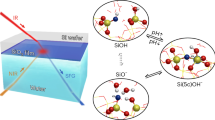Abstract
EXPERIMENTS have shown that, in certain conditions, a free water surface can exist in equilibrium with different values of surface tension in different regions. So far, only two such regions have been distinguished in any one water surface and their common boundary can be seen clearly in reflected light, after a little practice, as an unbroken sinuous line. One region appears to be chemically clean while the other is obviously contaminated with a surface film. This situation remains stable only if the water has a low velocity (less than 23 cm/see) which acts—see Fig. 1—in such a way that the contaminated surface region is “contained” by the shear stresses set up by the flow against the underside of the surface film. If the water velocity dies away the contaminated zone spreads out to cover the whole water surface. It is the line marking this boundary which is the subject of the present study and it will be referred to here as the “surface line”. This topic is of interest in chemical engineering where the results might be used to control the separation of minerals and other compounds by surface flotation.
This is a preview of subscription content, access via your institution
Access options
Subscribe to this journal
Receive 51 print issues and online access
$199.00 per year
only $3.90 per issue
Buy this article
- Purchase on SpringerLink
- Instant access to full article PDF
Prices may be subject to local taxes which are calculated during checkout
Similar content being viewed by others
References
Sellin, R. H. J., J. Sci. Instrum., 40, 355 (1963).
Author information
Authors and Affiliations
Rights and permissions
About this article
Cite this article
SELLIN, R. Existence of a Surface Tension Discontinuity at a Liquid Free Surface. Nature 217, 536–538 (1968). https://doi.org/10.1038/217536a0
Received:
Revised:
Issue date:
DOI: https://doi.org/10.1038/217536a0



